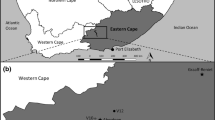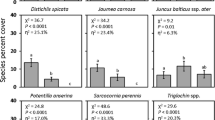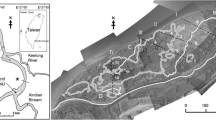Abstract
We investigated whether within wetland environmental conditions or surrounding land cover measured at multiple scales were more influential in structuring regional vegetation patterns in estuarine tidal wetlands in the Pacific Northwest, USA. Surrounding land cover was characterized at the 100, 250, and 1,000 m, and watershed buffer scales. Vegetation communities were characterized by high species richness, lack of monotypic zonation, and paucity of invasive species. The number of species per site ranged between 4 and 20 (mean ± standard deviation = 10.2 ± 3.1). Sites supported a high richness (mean richness of native species 8.7 ± 2.8) and abundance of native macrophytes (mean relative abundance 85 % ± 19 %). Vegetation assemblages were dominated by a mix of grasses, sedges, and herbs with Sarcocornia pacifica and Distichlis spicata being common at sites in the oceanic zone of the estuary and Carex lyngbyei and Agrostis stolonifera being common at the fresher sites throughout the study area. The vegetation community was most strongly correlated with salinity and land cover within close proximity to the study site and less so with land cover variables at the watershed scale. Total species richness and richness of native species were negatively correlated with the amount of wetland in the buffer at all scales, while abundance of invasive species was significantly correlated to within wetland factors, including salinity and dissolved phosphorus concentrations. Landscape factors related to anthropogenic disturbances were only important at the 100-m buffer scale, with anthropogenic disturbances further from the wetland not being influential in shaping the vegetation assemblage. Our research suggests that the traditional paradigms of tidal wetland vegetation structure and environmental determinants developed in east coast US tidal wetlands might not hold true for Pacific Northwest wetlands due to their unique chemical and physical factors, necessitating further detailed study of these systems.



Similar content being viewed by others
References
Adamus, P.R., J. Larsen, and R. Scranton. 2005. Wetland profiles of Oregon’s coastal watersheds and estuaries. Part 3 of a Hydrogeomorphic Guidebook, Report to Coos Watershed Association, US EPA, and Oregon Department of State Lands, Salem, OR.
Anderson, R.R., R.G. Brown, and R.D. Rappleye. 1988. Water quality and plant distribution along the upper Patuxent River, MD. Chesapeake Science 9: 145–156.
Armstrong, W., E.J. Wright, S. Lythe, and T.J. Gaynard. 1985. Plant zonation and the effects of the spring-neap tidal cycle on soil aeration in a Lumber salt marsh. Journal of Ecology 73: 323–339.
Barbour, M.G., and C.B. Davis. 1970. Salt tolerance of five California salt marsh plants. American Midland Naturalist 84: 262–265.
Bertness, M.D. 1991. Interspecific interactions among high marsh perennials in a New England salt marsh. Ecology 72: 125–137.
Bertness, M.D., and A.M. Ellison. 1987. Determinants of pattern in a New England salt marsh plant community. Ecological Monographs 57: 129–147.
Bertness, M.D., and P.J. Ewanchuk. 2002. Latitudinal and climate-drive variation in the strength and nature of biological interactions in New England salt marshes. Oecologia 132: 392–401.
Bertness, M.D., P.J. Ewanchuk, and B.R. Silliman. 2002. Anthropogenic modification of New England salt marsh landscapes. Proceedings of the National Academy of Sciences 99: 1395–1398.
Bilkovic, D.M., M. Roggero, C.H. Hershner, and K.H. Haves. 2006. Influence of land use on macrobenthic communities in nearshore estuarine habitats. Estuaries and Coasts 29: 1185–1195.
Brown, M.T., and M.B. Vivas. 2004. Landscape development intensity index. Environmental Monitoring and Assessment 101: 1–21.
Callaway, J.C., and J.B. Zedler. 2004. Restoration of urban salt marshes: lessons from southern California. Urban Ecosystems 7: 107–124.
Castellanos, E.M., M.E. Figueroa, and A.J. Davy. 1994. Nucleation and facilitation in salt marsh succession: interactions between Spartina maritima and Arthrocnemum perenne. Journal of Ecology 82: 239–248.
Castillo, J.M., L. Fernández-Baco, E.M. Castellanos, C.J. Luque, M.E. Figueroa, and A.J. Davy. 2000. Lower limits of Spartina densiflora and S. maritima in a Mediterranean salt marsh determined by different ecophysiological tolerances. Journal of Ecology 88: 801–812.
Chapman, V.J. 1974. Salt marshes and salt deserts of the world, 392. Germany: J. Cramer.
Crain, C.M., B.R. Silliman, S.L. Bertness, and M.D. Bertness. 2004. Physical and biotic drivers of plant distribution across estuarine salinity gradients. Ecology 85: 2539–2549.
Crossett, K.M., T.J. Culliton, P.C. Wiley, and T.R. Goodspeed. 2004. Population trends along the Coastal US: 1980–2008. NOAA Report, Washington D.C.
DeLuca, W.V., C.E. Studds, L.L. Rockwood, and P.P. Marra. 2004. Influence of land use on the integrity of marsh bird communities of the Chesapeake Bay, USA. Wetlands 24: 837–847.
Fariña, J.M., B.R. Silliman, and M.D. Bertness. 2009. Can conservation biologist rely on established community structure rules to manage novel systems?… Not in salt marshes. Ecological Applications 19: 413–422.
Fetscher, A.E., M.A. Sutula, J.C. Callaway, V.T. Parker, M. Vasey, J.N. Collins, and W.G. Nelson. 2010. Patterns of vegetation communities of estuarine wetlands in two California regions: insights from a probabilistic survey. Wetlands 30: 833–846.
Frenkel, R.E., and J.C. Morlan. 1991. Can we restore our salt marshes? Lessons from the Salmon River, Oregon. Northwest Environmental Journal 7: 119–135.
Frenkel, R.E., H.P. Eilers, and C.A. Jefferson. 1981. Oregon coastal salt marsh upper limits and tidal datums. Estuaries 4: 195–205.
Greenberg, R., J. Maldonado, and M.V. McDonald. 2006. Tidal marshes: a global perspective on the evolution and conservation of their terrestrial vertebrates. BioScience 56: 675–685.
Harper, J.L. 1977. Population biology of plants, 992. London: Academic.
Hickey, B.M., and N.S. Banas. 2003. Oceanography of the U.S. Pacific Northwest coastal ocean and estuaries with application to coastal ecology. Estuaries 26: 1010–1031.
Houlahan, J.E., P.A. Keddy, K. Makkay, and C.S. Findlay. 2006. The effects of adjacent land use on wetland species richness and community composition. Wetlands 26: 79–96.
Howes, B.L., R.W. Howard, J.M. Teal, and I. Valiela. 1981. Oxidation-reduction potentials in salt marshes: spatial patterns and interactions with primary production. Limnology and Oceanography 26: 350–360.
Jefferson, C.A. 1975. Plant communities and succession in Oregon coastal salt marshes. Ph.D. Dissertation, Oregon State Univ. Corvallis, OR, unpublished.
King, R.S., W.V. DeLuca, D.F. Whigham, and P.P. Marra. 2007. Threshold effects of coastal urbanization on Phragmites australis (common reed) abundance and foliar nitrogen in Chesapeake Bay. Estuaries and Coasts 30: 469–481.
Kunza, A.E., and S.C. Pennings. 2008. Patterns of plant diversity in Georgia and Texas salt marshes. Estuaries and Coasts 31: 673–681.
Lee II, H. and Brown, C.A. (2009) Classification of regional patterns of environmental drivers and benthic habitats in Pacific Northwest Estuaries. US EPA, Office of Research and Development, National Health and Environmental Effects Research Laboratory, Western Ecology Division, Newport, OR.
Lerberg, S.B., A.F. Holland, and D.M. Sanger. 2000. Responses of tidal creek macrobenthic communities to the effects of watershed development. Estuaries 23: 838–853.
MacArthur, R.H., and E.O. Wilson. 1967. The theory of island biogeography, 224. Princeton: Princeton University Press.
MEA. 2005. Ecosystems and human well-being: general synthesis. Millennium ecosystems assessment report, 160. Washington: Island Press.
Mendelssohn, I.A., K.L. McKee, and W.H. Patrick. 1981. Oxygen deficiency in Spartina alterniflora roots: metabolic adaptation to anoxia. Science 214: 439–441.
Miller, W.B., and F.E. Egler. 1950. Vegetation of the Wequetequock-Pawcatuck tidal marshes, Connecticut. Ecological Monographs 20: 143–172.
Mitsch, W.J., and J.G. Gosselink. 2007. Wetlands, 600. Hoboken: Wiley.
Naymik, J., Y. Pan, and J. Ford. 2005. Diatom assemblages as indicators of timber harvest effects in coastal Oregon streams. Journal of the North American Benthological Society 24: 569–584.
Niering, W.A., and R.S. Warren. 1980. Vegetation patterns and processes in New England salt marshes. BioScience 30: 301–307.
NOAA. 1998. NOAA’s Estuarine Eutrophication Survey, Volume 5: Pacific Coast Region. Silver Spring: Office of Ocean Resources Conservation and Assessment.
Odum, W.E. 1988. Comparative ecology of tidal freshwater and salt marshes. Annual Review of Ecology and Systematics 19: 147–176.
Pennings, S.C., and R.M. Callaway. 1992. Salt marsh plant zonation: the relative importance of competition and physical factors. Ecology 73: 681–690.
Pennings, S.C., and C.L. Richards. 1998. Effects of wrack burial in salt-stressed habitats: Batis maritima in a southwest Atlantic salt marsh. Ecography 21: 630–638.
Pennings, S.C., E.R. Selig, L.T. Houser, and M.D. Bertness. 2003. Geographic variation in positive and negative interactions among salt marsh plants. Ecology 84: 1527–1538.
Pennings, S.C., M. Bestor-Grant, and M.D. Bertness. 2005. Plant zonation in low-latitude salt marshes: disentangling the roles of flooding, salinity and competition. Journal of Ecology 93: 159–167.
Quinlan, J.R. 1986. Induction of decision trees. Machine Learning 1: 81–106.
Richards, C.L., S.C. Pennings, and L.A. Donovan. 2005. Habitat range and phenotypic variation in salt marsh plants. Plant Ecology 176: 263–273.
Sather, J.H., and P.J.R. Stuber. 1984. Proceedings of the national wetlands values assessment workshop. US Fish and Wildlife Service, Western Energy and Land Use Team, Washington, D.C.
Scranton, R. 2004. The application of Geographic Information Systems for delineation and classification of tidal wetlands for resources management of Oregon’s coastal watersheds. Master’s Thesis, Oregon State Univ, Corvallis, OR.
Seliskar, D.M., and J.L. Gallagher. 1983. The ecology of tidal marshes of the Pacific Northwest coast: a community profile. Washington: U.S. Fish and Wildlife Service, Division of Biological Services.
Sharpe, P.J., and A.H. Baldwin. 2009. Patterns of wetland plant species richness across estuarine gradients of the Chesapeake Bay. Wetlands 29: 225–235.
Silliman, B.R., and M.D. Bertness. 2002. A trophic cascade regulates salt marsh primary production. Proceedings of the National Academy of Sciences of the United States ofAmerica 99: 10500–10505.
Silliman, B.R., and J.C. Zieman. 2001. Top-down control of Spartina alterniflora production by periwinkle grazing in a Virginia salt marsh. Ecology 82: 2830–2845.
Therneau, T.M., and E.J. Atkinson. 1997. An introduction to recursive partitioning using the RPart routines. Rochester: Mayo Foundation.
Tilman, D. 1988. Plant strategies and the dynamics and structure of plant communities, 360. Princeton: Princeton University Press.
USGS. 2000. Oregon Wetland Resources. http://or.water.usgs.gov/pubs/Online/Html/WSP2425/. Accessed 2/17/2011.
Valiela, I., and J.M. Teal. 1974. Nutrient limitation of salt marsh vegetation. In Ecology of Halophytes, ed. R.J. Reimold and W.H. Queen, 547–563. New York: Academic.
Venables, W.N., and B.D. Ripley. 2002. Modern and applied statistics with S-Plus, 520. New York: Springer.
Weilhoefer, C.L., and Y. Pan. 2008. Using change-point analysis and weighted averaging approaches to explore the relationships between common benthic diatoms and in-stream environmental variables in Mid-Atlantic Highlands streams, USA. Hydrobiologia 614: 259–274.
Wigand, C., R.A. McKinney, M.A. Charpentier, M.M. Chintala, and G.B. Thursby. 2003. Relationships of nitrogen loadings, residential development, and physical characteristics with plant structure in New England salt marshes. Estuaries 26: 1494–1504.
Zedler, J.B. 1982. The ecology of southern California coastal salt marshes. US Fish and Wildlife Service Biological Report. Washington, D.C.
Zedler, J.B., J.C. Callaway, J.S. Desmond, G. Vivian-Smith, G.D. Williams, G. Sullivan, A.E. Brewster, and B.K. Bradshaw. 1999. Californian salt-marsh vegetation: an improved model of spatial pattern. Ecosystems 2: 19–35.
Author information
Authors and Affiliations
Corresponding author
Rights and permissions
About this article
Cite this article
Weilhoefer, C.L., Nelson, W.G., Clinton, P. et al. Environmental Determinants of Emergent Macrophyte Vegetation in Pacific Northwest Estuarine Tidal Wetlands. Estuaries and Coasts 36, 377–389 (2013). https://doi.org/10.1007/s12237-012-9569-9
Received:
Revised:
Accepted:
Published:
Issue Date:
DOI: https://doi.org/10.1007/s12237-012-9569-9




